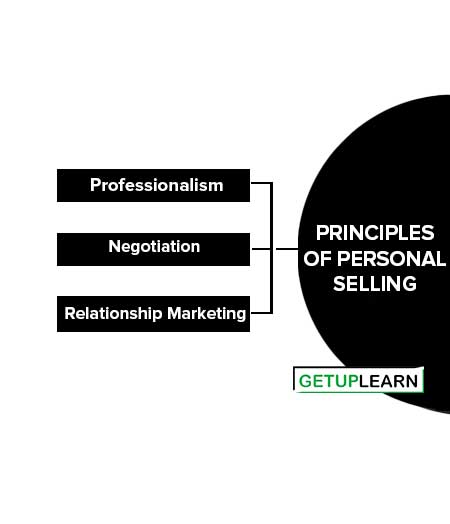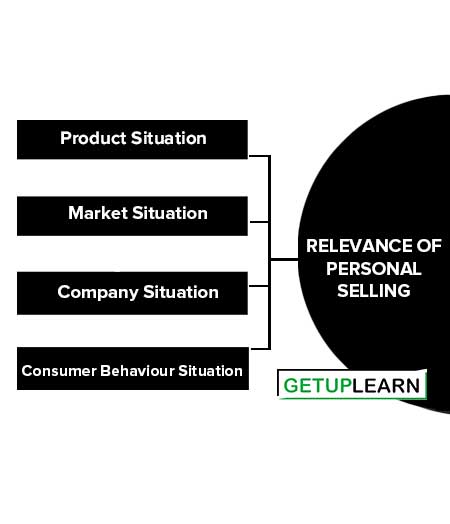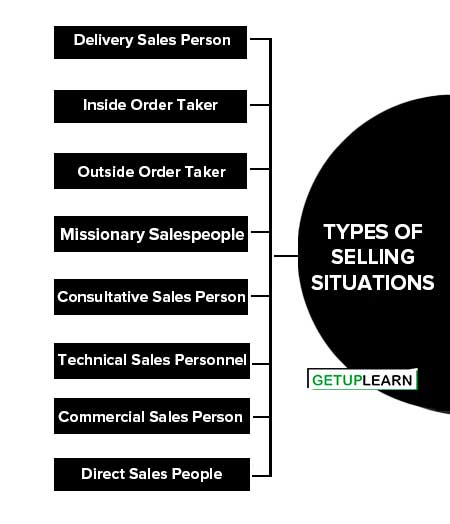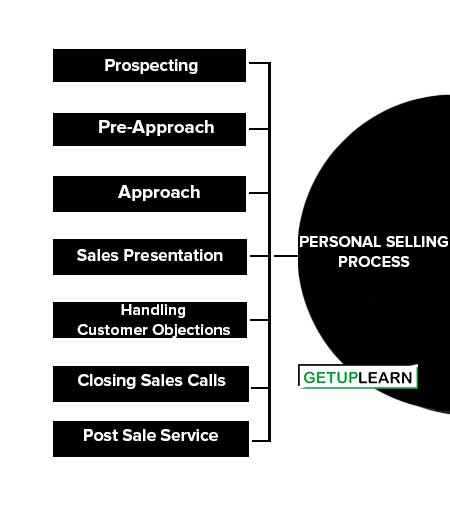Table of Contents
What is Personal Selling?
Personal selling is an important aspect of marketing and is a broader concept than salesmanship. Personal Selling is an overall activity and salesmanship is one aspect of personal selling. In fact, salesmanship is one of the skills used in personal selling.
Personal selling together with other marketing elements such as pricing, advertising, product development, marketing channels, and physical distribution is a means for implementing marketing programs.
However, personal selling efforts are largely obtained through the salesmanship of various sales forces. J Shapiro defines personal selling, as “it is the area to successfully persuade prospective customers to buy products or services from which they can derive certain benefits and thereby increasing their total satisfaction.”
Hence, personal selling is the primary relationship between the buyer and the seller, and their interaction only results in a sale.
Objectives of Personal Selling
Personal selling objectives are related to the overall marketing plan, especially the promotional plan. These objectives are influenced by promotional mix strategies followed by the company. These objectives of personal selling could be quantitative or qualitative.
The quantitative objective would be emphasizing the short-term company objectives whereas qualitative objectives are based on achieving long-term objectives and also guide the setting of quantitative objectives.
- To do the entire selling job (when there are no other elements in the promotional mix).
- To “service” existing accounts (that is, to maintain contacts with present customers, take orders, and so forth).
- To search out and obtain new customers.
- To secure and maintain customers’ cooperation in stocking and promoting the product line.
- To keep customers informed on changes in the product line and other aspects of marketing strategy.
- To assist customers in selling the product line (as through “missionary selling”).
- To provide technical advice and assistance to customers (as with complicated products and where products are specially designed to fit buyers’ specializations).
- To assist (or handle) the training of middlemen’s sales personnel.
- To provide advice and assistance to middlemen on management problems.
- To collect and report market information of interest and use to company management.
Principles of Personal Selling
Personal selling is more of an art. Often effective salespersons have an instinct. Yet, it is realized that proper training can enhance the skills of good salesmen. In present times, personal selling is becoming more and more customer-oriented because no more do are have a buyer’s market. Three major principles of personal selling are:

Professionalism
The belief that good sales are born is giving way to a professional approach to sales activity. The sales managers realize the importance of training the sales force and spend huge sums of money each year for the same.
We find the market flooded with training aids comprising of books, video and audiocassettes, CDs, and many more. The aim at sharpening the skills of a salesman to make him more and more effective. All sales training approaches try to convert a salesperson from a passive order taker into an order setter.
An order taker is passive and is dominated by the situation. An order-getter molds the situation in his favor and takes charge in order to achieve his objectives. The modern professional approach to salesmanship is customer oriented.
The act of selling is projected as aimed at solving the problems of the customers. Such an approach is satisfying the customers more thereby making sales activity more and more effective. The sales personnel are trained to understand the situation and then formulate their reaction because no single approach works in all situations.
Negotiation
Negotiation skills are one of the most important skills of a salesman. The two parties need to reach an agreement on price and other terms of sale. A good salesman wins the order without making deep .concessions that will hurt his profitability. Also, he must not unduly extract the customer because such as approach will be detrimental in the long run.
This process of exchange by way of negotiation is more of an art. Learned by a salesman over time. The professional approach to negotiation identifies the zone of agreement between the seller’s surplus and the buyer’s surplus.
Such an understanding helps in reaching the agreement point where both parties feel satisfied. Negotiation involves communication that is focused and planned. A good salesman understands his customer well and then formulates a negotiation strategy.
Relationship Marketing
As the salesman becomes close to the customers, the transactional nature of the selling approach gives way to the relationship approach. The transactional approach is deal to deal approach centered on short-term gains. The relationship approach is long-term and establishes a relationship between the buyer and the seller.
Both understand each other and support each other. Sales managers have realized that it is far easier to get sales from an old customer as compared to getting the same from a new customer. So, it is important to retain the existing customers.
Personal selling is the most effective method of building relationships. No other means can establish relationships as effectively as personal selling does. So modern salesmen work with a long-term perspective, establishing close customer associations. Such a practice is most evident in banking, airlines, insurance, and investment industries.
Relevance of Personal Selling
Let us discuss some of the situations when personal selling in a company becomes more relevant:

Product Situation
Personal selling is relatively more effective and economical in the case:
- When a product is of a high unit value like Xeroxing machine, computers, etc.
- When a product is in the introductory stage of its life cycle and requires the creation of core demand.
- A product requires personal attention to match specific consumer needs e.g. insurance policy.
- Product requires demonstration e.g. most of the industrial products.
- The product requires after-sales service.
- The product has no brand loyalty or very poor brand loyalty.
Market Situation
Personal selling situation can be best utilized when:
- A company is selling to a small number of large-size buyers.
- A company sells in a small-local market or in a government or institutional market.
- Desired middlemen or agents are not available.
- An indirect channel or distribution is used for selling to merchant-middlemen only.
Company Situation
Personal selling is relatively more effective and economical when:
- The company is not in a position to identify and make use of suitable non-personal communication media.
- A company cannot afford to have a large and regular advertising outlay.
Consumer Behaviour Situation
Personal selling is more effective when:
- Purchases are valuable but infrequent.
- Consumer needs instant answers to their questions.
- The consumer requires persuasion and follow-up in the face of competitive pressure.
Types of Selling Situations
All of us being consumers often come across a variety of selling situations. Differences in marketing factors cause each company to have individualized selling styles. Each different type of selling job requires the salesperson to perform a variety of different tasks and activities under different circumstances.
The job of a soft drink driver salesperson who calls in a routine fashion on a number of retail stores is different from that of a computer salesperson who sells a system for managing information to the executive of a consultancy firm.
Before categorizing salespersons into basic selling styles, one convenient way to classify the many different types of sales jobs is to array them on the basis of the creative skill required in the job, from simple service-or repeat order selling to complex developmental selling. Let us now discuss the different types of selling situations:
- Delivery Sales Person
- Inside Order Taker
- Outside Order Taker
- Missionary Salespeople
- Consultative Sales Person
- Technical Sales Personnel
- Commercial Sales Person
- Direct Sales People

Delivery Sales Person
The primary job of the delivery salesperson is to deliver the product e.g. soft drinks, bread, milk, etc. The selling responsibilities are secondary. Good service and a pleasant personality may lead to more sales.
Inside Order Taker
The retail salesperson standing behind a counter is an inside order taker. The customer comes to the salesperson with the intention to buy a product or service, the salesperson only serves him or her. The salesperson may use suggestion selling but ordinarily cannot do much more.
Outside Order Taker
The soap or spices salesperson calling on the retailer is an outside order taker. They do little creative selling. In contrast with store personnel, these representatives actually may be discouraged from doing any hard selling. That task is left to executives higher in the hierarchy.
Missionary Salespeople
These salespersons are not expected or permitted to solicit an order. Their job is to build goodwill or to educate actual or potential users or provide services for the customers, as in the case of Medical representatives, working for the pharmaceutical company.
Consultative Sales Person
Consultative sales are characterized by the product or service that is sold at the higher level of an organization e.g. computer system or management consultancy service. The decision to purchase such products involves higher capital outlay thus sales job requires a low-key, low-pressure approach by the salesperson.
It would also require a very strong knowledge of the product, patience to discuss the product with several people in the organization, and potential benefits to the user. Even at times when the progress of sales slows down representative has to make creative and sensitive efforts to resume interest without appearing to exert pressure on the prospect.
Technical Sales Personnel
The most distinctive characteristic of technical sales is the product knowledge required by its salesperson, unlike consultative sales, where sophistication in organizational relationships and persuasive ability are the salespersons’ most valuable assets. Even the time required to sell the product is relatively less than consultative sales.
Most technical purchasing requires the approval of several people but only one or two people with technical knowledge influence decisions. If the sales representative is able to satisfy these people with product characteristics, application, and installation process, approval from higher management is usually forthcoming.
The technical sales persons though not strangers to the process of making a sale, are trained to utilize the rational approach, by going into details of product utility and features.
Commercial Sales Person
This field generally includes non-technical sales to businesses, industry, government, and non-profit organizations e.g. office equipment, wholesale goods, building products, business services, and others. Unlike the previous two types, it is customary for the commercial salesperson to make sales on the first or second call.
The process stresses the approach to the right person (decision maker), making a smooth presentation, and closing the sales. The field is composed of order takers, to follow up and maintenance of accounts and order getters, to develop new accounts. Since these require different approaches, they normally require different personality traits e.g. the order-getter is more aggressive and more highly motivated.
Direct Sales People
Direct sales are primarily concerned with the sales of products and services to ultimate consumers e.g. restaurants, door-to-door sales, insurance, encyclopedias, magazines, etc. There is normally some emotional appeal associated with this type of selling, thus sales persons are required to possess the strong persuasive ability.
Often the length of time to close sales is the shortest in the case of the above product categories. In fact, sales personnel are trained to close the sales on the first visit because it is felt if consumers are given time, they will either cool off from buying or will buy from a competitor.
Personal Selling Process
You may have observed the process adopted by successful salespersons from insurance companies or companies selling consumer durables or non-durables. In order to make sales happen, they carefully handle the customer. They lead the customer through a process so that the sale takes place. The elements of the personal selling process are:
- Prospecting
- Pre-Approach
- Approach
- Sales Presentation
- Handling Customer Objections
- Closing Sales Calls
- Post Sale Service

Prospecting
Prospecting refers to locating prospective buyers. Good salesmen do not entirely rely on existing customers, but seek out new ones. They constantly search for ‘prospects’ or potential customers and rope in as many of them as possible. Prospecting is the step in the selling process whenever new customers are sought. Prospecting can be carried out in the following ways:
-
Identifying prospects and gathering leads: Although the company may supply some leads, the salesman must have the skill to develop their own leads. They can develop leads from many sources such as:
- Current customers
- Dealers
- Suppliers, non-competing salesman, banks, credit agencies, and club/similar organizations.
- Published data sources like directories, telephone yellow pages, etc.
-
Qualifying the prospects and analyzing their purchases: Salesmen have to screen the leads, throw out the poor ones and pick the better ones for further probing/making sales calls. He could call up or write to the prospects before deciding whether to make a sales call.
Prospects should be qualified by evaluating their financial ability, likely volume of purchase, specifications adopted, likelihood of continuous business, etc. The leads can also be categorized into hot leads, warm leads, and cool leads, depending on their potential to become customers.
- Using Websites: Websites can be used for acquiring and qualifying leads. Salesmen can use websites of companies/ social network sites for acquiring leads and qualifying prospects. A lot of details about the prospects can be collected by perusing the sites. Websites analysis is a valuable tool and can help select exactly those who warrant a personal sales call.
Pre-Approach
Pre-approach consists of planning and preparation. The salesmen have to meticulously plan the sales presentation. They must go through customer characteristics and the sales context as part of the preparation.
The salesperson should know how to greet the buyer to get the relationship off to a good start. The sales presentation has to be detailed with the exact needs of the customer. Securing appointments/sales interviews from the customer is also a part of the preparation.
Approach
The approach refers to the preliminaries and the initial part of the interaction in sales interviews before the substantive sales presentation commences. In particular, it includes the opening remarks in the presentation and the opening style adopted by the salesman in selling to the given customer. In general, a consultative style of selling is superior to a totally controlled one. The approach should facilitate this requirement.
Sales Presentation
The salesperson has now to tell a product story to the buyer. The salesman has to make the actual delivery of the sales story/message/demonstration. The salesperson should try to gain attention, hold interest, arouse desire, obtain action, and enduring satisfaction. In short, this method is called AIDAS.
Listening, probing, use of questions, and persuasive interceptions are integral elements in the process. Handling and overcoming objections is also a part of it. The salesman must involve the customer in the presentation. Companies generally develop three different styles of sales presentation. The first one is called as canned approach, which is a memorized sales talk covering the main points.
It is based on stimulus–response thinking, that is, the buyer is passive and can be moved to purchase by the use of the right stimulus words, pictures terms, and actions.
The second approach is the formulated approach which is based on stimulus-response thinking but first identifies the buyer’s needs and buying style and then uses this approach to the buyer. The third can be named as need satisfaction approach which starts with a search for the customer’s real needs by encouraging the customer to do more of the talking.
Handling Customer Objections
Consumers always pose objections during the presentations or at the time of ordering the product. Psychological resistance includes resistance to interference, preference for established supply sources or brands, reluctance to new ideas, dislike of making independent decisions, and so on.
Logical resistance might consist of objections to the price, delivery schedule, or certain product or company characteristics. To handle these objections, the salesperson needs to maintain a positive approach. He should allow the buyer to clarify objections. Handling and overcoming objections is a part of the broader skills of negotiation.
Closing Sales Calls
The salesperson now attempts to close the sale. Some salespeople do not get to this stage. They lack confidence or feel uncomfortable about asking for the order. Many a time they fail to recognize the right psychological movement to close the sale.
Salespersons need to know how to recognize closing signs from the buyer, including physical actions, statements or comments, and questions. Salespersons can use one of the several closing techniques.
Post Sale Service
Post-sale service to the customers is another important element. Salesmen must promptly respond to service requests from customers and follow them up with concerned individuals/departments of the company. In his article titled, ‘After the sale is over’, Professor Levitt says that salesmen have to go beyond the immediate goal of the sale.
He emphasizes the need for developing professional partnerships between the seller and the buyer. Only when this is achieved can the buyer-seller relationship bring profits to the company? It is not enough for a salesman to create a satisfied customer. There is a need to retain satisfied customers through-post sale service.
What are the types of selling situations?
These are the types of selling situations: 1. Delivery Sales Person 2. Inside Order Taker 3. Outside Order Taker 4. Missionary Salespeople 5. Consultative Sales Person 6. Technical Sales Personnel 7. Commercial Sales Person 8. Direct Sales People.
What is the personal selling process?
The following are the steps of the personal selling process: 1. Prospecting 2. Pre-Approach 3. Approach 4. Sales Presentation 5. Handling Customer Objections 6. Closing Sales Calls 7. Post Sale Service.
